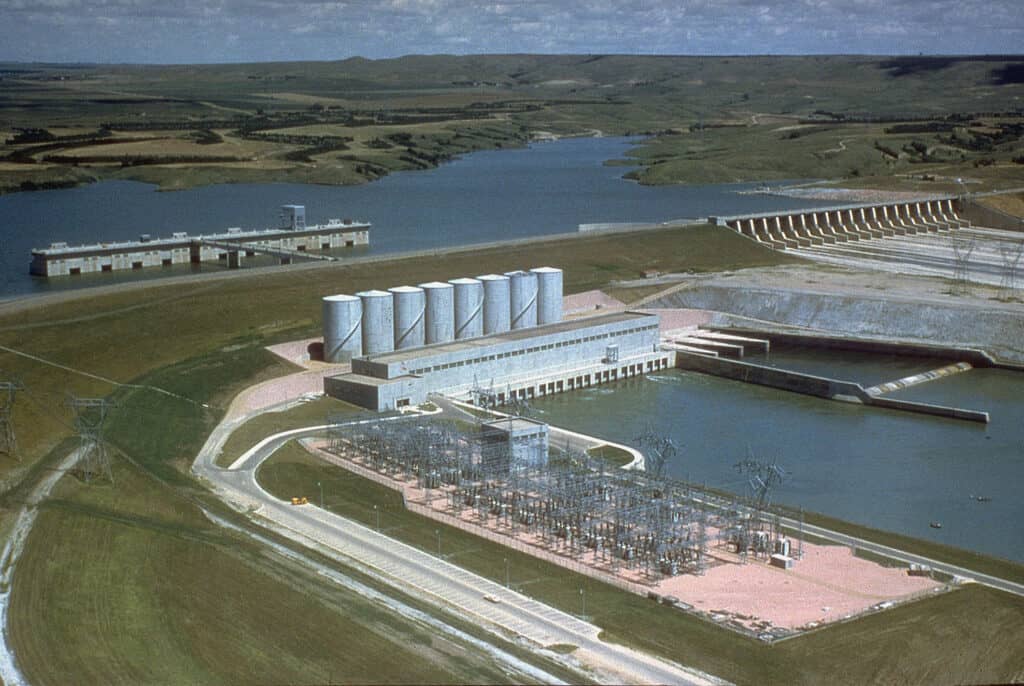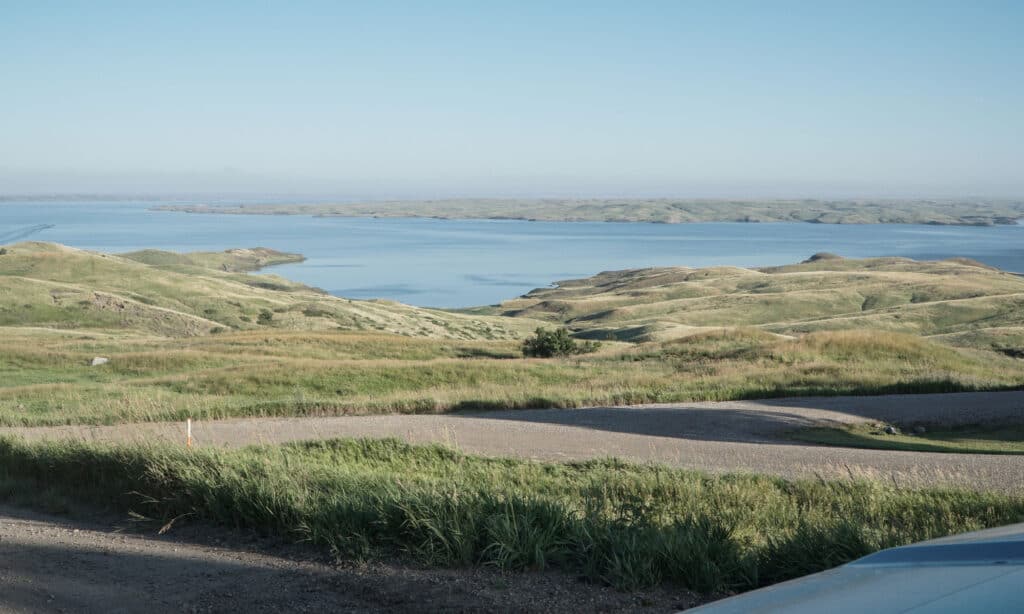Nestled in the heart of the United States, South Dakota is a magnificent state with rough natural beauty and various scenic attractions. South Dakota’s diversified geography welcomes nature lovers to explore the state, with rolling prairies, badlands, deep underground tunnels, rich green forests, and stunning lakes. Western South Dakota, eastern South Dakota, and the Black Hills are the three separate regions that make up Mount Rushmore State.
The Missouri River divides the state in two, geographically splitting east and west. The eastern half of South Dakota is the most populated, as it’s the state’s flattest portion, and the western half contains hilly and mountainous terrain. The state’s eastern side is home to many different lakes that sprouted during the recent ice age. Some of the lakes are small, whereas others cover an area of more than 120,000 hectares. They come in diverse shapes and sizes, and their depth varies depending on whether they are in the mountains or at sea level. Regardless, they are all amazing. Below are South Dakota’s 10 biggest lakes.
The 10 Biggest Lakes in South Dakota
10. Shadehill Reservoir
Shadehill Reservoir is a reservoir on the Grand River in Perkins County, South Dakota, that was built in 1951 by the US Bureau of Reclamation’s Shadehill Dam. Walleye, smallmouth bass, channel catfish, yellow perch, northern pike, and common carp are among the fish species that thrive in the 4,693-acre (18.99 km²) lake. The South Dakota Department of Game, Fish, and Parks manages the larger Llewellyn Johns Recreation Area and the smaller Llewellyn Johns Recreation Area that offer camping, swimming, picnics, and boating.
Hugh Glass Lakeside Use Area, named after the mountain man Hugh Glass, is located around the reservoir managed by the Game, Fish, and Parks, and a historical monument honoring Hugh Glass lies near the site of his mauling.
9. Lake Kampeska

The most developed lake in South Dakota is Lake Kampeska.
©iStock.com/Jacob Boomsma
Lake Kampeska is an inland glacial lake with a surface area of 5,250 acres. It is entirely within Codington County and the Coteau des Prairies, located west-northwest of Watertown, South Dakota. The lake is naturally shaped and has over 13.5 miles (20 kilometers) of residential shoreline, making it the most developed lake in South Dakota. A single inlet-outlet canal on the northeast side of Lake Kampeska connects it to the Big Sioux River. Recreational activities such as fishing, boating, swimming, waterskiing, camping, and picnicking are popular at the lake. The fishery of Lake Kampeska thrives with smallmouth bass and walleye, although it also includes crappie (black and white), bluegill, channel catfish, northern pike, and white bass.
8. Lake Poinsett
Lake Poinsett spans nearly 8,000 acres, and is not only one of the state’s largest but also one of the most visited. This is because of its fantastic recreation area, situated on the lake’s southern edge. The lake’s name came from Joel Poinsett, the US Secretary of War before, and was essential in supporting the area’s exploration. Explorers camped along the lake’s coastline in 1838, and it’s still a popular spot for camping today. A visit to this gorgeous lake will provide you with fun-filled activities to make your trip memorable. If you appreciate water activities, consider going on a boating trip and swimming in the calm waters. Play a round of golf along the beautiful lake if you’re into golf.
7. Lake Traverse
Lake Traverse sits at the southern part of Hudson Bay watershed of North America, sitting on the border between Minnesota and South Dakota. Lac Traverse is an Anglicization of the French term Lac Traverse, which means “across the lake.” Looking back, the lakeshores were utilized as a trading post as early as 1786, with the Hudson Bay Company following in 1792. The 11,528-acre lake is now a popular destination for water sports aficionados. In summer, the lake bustles with activities like swimming, boating, sailing, canoeing, water skiing, fishing, and more. Cross-country skiing, snowmobiling, and ice fishing are popular winter sports during the cooler months. Fish are abundant in spring (pre-spawn) patterns, with walleye, largemouth bass, smallmouth bass, crappie, panfish, bluegill, northern pike, yellow perch, white bass, catfish, common carp, and the drum among the species available.
6. Big Stone Lake

The lowest point in South Dakota is Big Stone Lake.
©McGhiever / Creative Commons – License
Big Stone Lake is a long, slim freshwater lake in the United States that is on the border between western Minnesota and northeastern South Dakota. The lake is 12,610 acres (51.03 km²) in size, reaching 26 miles (42 kilometers) from end to end and about 1 mile (1.6 kilometers) in width. It is the lowest point in South Dakota, at 965 feet (294 meters). Big Stone Lake is a magnificent lake that invites you to relax and enjoy its natural surroundings. This freshwater lake provides peaceful lakeside camping places where you can experience the pleasures of camping. Because it is home to a variety of fish, it is also a great place to go fishing. Birdwatchers can bring their binoculars and look for gorgeous birds flying around.
5. Bitter Lake

Walleye are among the most popular gamefish in North America.
©iStock.com/FedBul
Day County, South Dakota, is home to Bitter Lake. It covers 15,000 acres and reaches about 24 feet at its deepest point. Bitter Lake is the poster child for eastern South Dakota’s developing fisheries. Bitter was once a little duck slough, but years of heavy rain have transformed it into one of the state’s massive bodies of water. The expansion of the fishery into adjacent sloughs has resulted in a wide range of habitats, including deepwater, shallow water, and everything in between. Bitter’s clear waters make it possible to attract fish from afar. It is known for its walleye fishing, but it also has a lot of yellow perch and northern pike.
4. Lake Thompson

The sixth-largest lake in South Dakota is Lake Thompson.
©Scott Thompson / Creative Commons – License
Lake Thompson is the sixth-largest lake in South Dakota and one of the country’s largest natural lake, located in Kingsbury County. It has a 16,236-acre surface area and a depth of 26 feet. Anglers flock to the lake because it is home to different fish species such as sunfish, northern pike, walleye, black bullheads, and others. The Lake Thompson Recreation Area lies on the lake’s northeast shoreline and is the main attraction for most visitors. It has 103 campsites, five cabins, a playground, and a beach with water skiing. You can also go on a hiking excursion and explore several picturesque nature routes if you enjoy hiking. Migratory birds rely on Lake Thompson for their survival. For shorebirds, waterfowl, wading birds, and gulls, the presence of open water, shallow mudflats, cattail marshes, and wet meadows creates a diversified habitat. While pelicans, gulls, terns, and ducks thrive in the open water.
3. Lake Sharpe

Spanning five countries and holding a surface size of 56,884 acres, Lake Sharpe is one of the largest reservoirs in South Dakota.
©Harry Weddington, U.S. Army Corps of Engineers / This image or file is a work of a U.S. Army Corps of Engineers soldier or employee, taken or made as part of that person’s official duties. As a work of the U.S. federal government, the image is in the public domain.
Lake Sharpe, which spans five counties and has a surface size of 56,884 acres, is one of the state’s largest reservoirs. It resembles more of a river than a lake because it is the third-largest lake in South Dakota. Former state governor Merrill Q. Sharpe, who grew up in a community directly south of the lake, inspired the lake’s name. Walleye abound in Lake Sharpe, to the point where there were 160,000 walleye in 1997. If you enjoy boating, the lake offers a boat ramp, and you can embark on a boating excursion. Picnicking is a lot of fun, and there are plenty of scenic waterfront pathways to discover. Expect to see whitetail and mule deer, elk, bison, coyotes, and wild turkeys among the big game animals. Ducks, geese, pheasants, prairie chickens, and grouse are examples of waterfowl and upland game birds.
2. Lake Francis Case

The second largest lake is South Dakota is Lake Francis Case.
©Harry Weddington, U.S. Army Corps of Engineers / This image or file is a work of a U.S. Army Corps of Engineers soldier or employee, taken or made as part of that person’s official duties. As a work of the U.S. federal government, the image is in the public domain.
With a surface area of 102,005 acres, Lake Francis Case is South Dakota’s second-largest lake. The lake, spread in the counties of Charles Mix, Gregory, Lyman, Brule, and Buffalo, is the eleventh-largest reservoir in the United States. Are you seeking a rejuvenating sabbatical amid beautiful nature? Plan a trip to Lake Francis Case in South Dakota, a large and stunning lake. Many golden bald eagles live on the Fort Randall Dam, impounding this fascinating lake. While camping near the lake, keep a close eye on this gorgeous flying bird. Water skiing, fishing, swimming, hiking, and boating are just a few of the wonderful activities available.
1. Lake Oahe

The largest Lake in South Dakota is the Lake Oahe.
©iStock.com/Chaden Roggow
Lake Oahe is the largest lake in South Dakota by surface area and the country’s fourth-largest reservoir by volume. It is nestled in the central South Dakota and stretches into North Dakota to the north. The lake is 369,917 acres (1,497 km²) in size and has a maximum depth of 205 feet (62 m). Every year, about 1.5 million people come to enjoy the lake’s recreational activities, including boating, fishing, hiking, and camping. Swimming is also available in Oahe Downstream Recreation Area, Cow Creek Recreation Area, and Revheim Bay Recreation Area. Due to the cold, deepwater habitats, Chinook salmon thrive in Lake Oahe and the Oahe Tailwaters. Rainbow smelt and lake herring are their primary food sources. Walleye, northern pike, channel catfish, and smallmouth bass are among the other fish species found in the reservoir. The endangered Pallid sturgeon also lives in the lake.
Summary of the 10 Biggest Lakes in South Dakota
| Rank | Lake | Size | Activities |
|---|---|---|---|
| 10 | Shadehill Reservoir | 4,693-acre (18.99 km²) | Camping, swimming, picnics, and boating |
| 9 | Lake Kampeska | 5,250 acres | Fishing, boating, swimming, waterskiing, camping |
| 8 | Lake Poinsett | 8,000 acres | Boating, camping, swimming |
| 7 | Lake Traverse | 11,528 acres | Swimming, boating, sailing, canoeing, water skiing, fishing, cross-country skiing, snowmobiling, and ice fishing |
| 6 | Big Stone Lake | 12,610 acres (51.03 km²) | Birdwatching, camping, fishing |
| 5 | Bitter Lake | 15,000 acres | Fishing |
| 4 | Lake Thompson | 16,236 acres | Birdwatching, camping, hiking, water skiing |
| 3 | Lake Sharpe | 56,884 acres | Boating, picnics |
| 2 | Lake Francis Case | 102,005 acres | Water skiing, fishing, swimming, hiking, and boating |
| 1 | Lake Oahe | 369,917 acres (1,497 km²) | Boating, fishing, hiking, and camping |
The photo featured at the top of this post is © John Brueske/Shutterstock.com
Thank you for reading! Have some feedback for us? Contact the AZ Animals editorial team.






